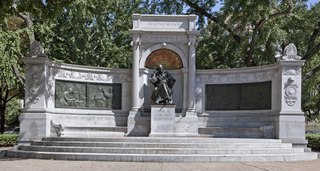 Monument in 2010 | |
 | |
| 38°54′26″N 77°02′09″W / 38.907256°N 77.035725°W | |
Samuel Hahnemann Monument | |
| NRHP reference No. | 07001055[1] |
|---|---|
| Added to NRHP | October 11, 2007[2] |
| Location | Reservation 64, Scott Circle, Washington, D.C., United States |
| Designer |
|
| Material |
|
| Length | 2.5 feet (0.76 m) |
| Width | 3 feet (0.91 m) |
| Height | 6 feet (1.8 m) |
| Opening date | June 21, 1900 |
| Dedicated to | Samuel Hahnemann |
The Samuel Hahnemann Monument, also known as Dr. Samuel Hahnemann, is a public artwork dedicated to Samuel Hahnemann, the founder of homeopathy. It is located on the east side of Scott Circle, a traffic circle in the northwest quadrant of Washington, D.C. The Classical Revival monument consists of an exedra designed by architect Julius Harder and a statue sculpted by Charles Henry Niehaus, whose works include the John Paul Jones Memorial in Washington, D.C., and several statues in the National Statuary Hall Collection. The monument is significant because Hahnemann is the first foreigner not associated with the American Revolution to be honored with a sculpture in Washington, D.C.
The monument was dedicated in 1900 following years of fundraising efforts by the American Institute of Homeopathy. Among the thousands of attendees at the dedication ceremony were prominent citizens including President William McKinley, Attorney General John W. Griggs, and General John Moulder Wilson. The monument was rededicated in 2000 and a restoration process was completed in 2011. It was listed on the National Register of Historic Places in 2007. The monument and surrounding lot are owned and maintained by the National Park Service, a federal agency of the Interior Department.
- ^ "National Register Information System". National Register of Historic Places. National Park Service. July 9, 2010.
- ^ "District of Columbia Inventory of Historic Sites" (PDF). District of Columbia Office of Planning – Historic Preservation Office. September 30, 2009. Archived from the original (PDF) on November 5, 2014. Retrieved February 11, 2014.